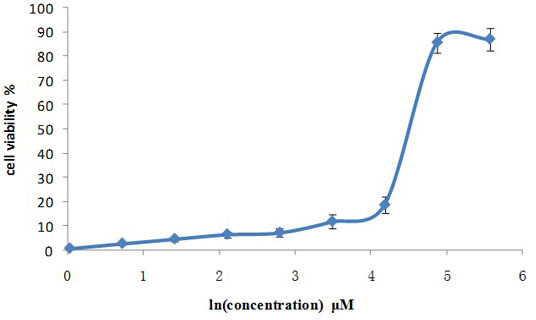Apoptosis-Inducing Effect of Ginsenoside Rg6 on Human Lymphocytoma JK Cells
Abstract
:1. Introduction

2. Results and Discussion
2.1. Influence of Different Concentrations of GRg6 on Cell Proliferation
| Group (μM) | GRg6 | ||
|---|---|---|---|
| OD ± SD | IR (%) | IC50 | |
| Negative | 1.181 ± 0.013 | — | 83.08 μM |
| Positive | 0.150 ± 0.003 | 87.27 | |
| 1.02 | 1.171 ± 0.015 | 0.82 | |
| 2.04 | 1.147 ± 0.018 | 2.85 | |
| 4.08 | 1.125 ± 0.011 | 4.74 | |
| 8.15 | 1.102 ± 0.021 | 6.63 | |
| 16.31 | 1.094 ± 0.017 | 7.34 | |
| 32.62 | 1.040 ± 0.014 | 11.94 | |
| 65.23 | 0.959 ± 0.006 | 18.75 | |
| 130.46 | 0.169 ± 0.002 | 85.71 | |
| 260.93 | 0.152 ± 0.002 | 87.10 | |

2.2. Hochest33258 Fluorescence Staining to Detect Cell Apoptosis

2.3. Annexin-V FITC/PI Double-staining Method to Detect Cell Apoptosis

2.4. PI Single-Staining Method to Detect the Cell Cycle

2.5. JC-1 Staining Method to Detect Mitochondrial Membrane Potential

2.6. Western Blot to Detect Protein Expression

2.7. Discussion
3. Experimental
3.1. Materials
3.1.1. Cell Strain
3.1.2. Medicine and Groups
3.1.3. Main Reagents and Consumables
3.2. Methods
3.2.1. Cell Culture
3.2.2. CCK-8 Method to Measure Cell Proliferation
3.2.3. Hochest33258 Fluorescence Staining
3.2.4. Annexin-V FITC/PI Double Staining Method to Detect Cell Apoptosis
3.2.5. PI Single-Staining Method to Detect the Cell Cycle
3.2.6. JC-1 Staining Method to Detect Mitochondrial Membrane Potential
3.2.7. Western Blot Method to Detect Protein Expression
3.3. Statistical Analyses
4. Conclusions
Acknowledgments
Conflicts of Interest
References
- Sun, S.; Wang, C.Z.; Tong, R.; Li, X.L.; Anna, F.; Wang, Q.; He, T.C.; Du, W.; Yuan, C.S. Effects of steaming the root of Panax notoginseng on chemical composition and anticancer activities. Food Chem. 2010, 118, 307–314. [Google Scholar] [CrossRef]
- Toh, D.F.; Dhavalkumar, N.P.; Chan, E.C.Y.; Teo, A.; Neo, S.Y.; Koh, H.L. Anti-proliferative effects of raw and steamed extracts of Panax notoginseng and its ginsenoside constituents on human liver cancer cells. Chin. Med. 2010, 6, 4–34. [Google Scholar]
- Lee, J.G.; Lee, Y.Y.; Wu, B.; Kim, S.Y.; Lee, Y.J.; Yun-Choi, H.S.; Park, J.H. Inhibitory activity of ginsenosides isolated from processed ginseng on platelet aggregation. Pharmazie 2010, 65, 520–522. [Google Scholar]
- Sun, S.; Qi, L.W.; Du, G.J.; Mehendale, S.R.; Wang, C.Z.; Yuan, C.S. Red notoginseng: Higher ginsenoside content and stronger anticancer potential than Asian and American ginseng. Food Chem. 2011, 125, 1299–1305. [Google Scholar] [CrossRef]
- Kim, D.-H. Chemical Diversity of Panax ginseng, Panax quinquifolium, and Panax notoginseng. J. Ginseng Res. 2012, 36, 1–15. [Google Scholar] [CrossRef]
- Kroemer, G.; Dallaporta, B.; Resch-Rigon, M. The mitochondrial death/life regulator in apoptosis and necrosis. Ann. Rev. Physiol. 1998, 60, 619–642. [Google Scholar] [CrossRef]
- Sample Availability: Samples of the compounds ginsenoside Rg6 are available from the authors.
© 2013 by the authors; licensee MDPI, Basel, Switzerland. This article is an open access article distributed under the terms and conditions of the Creative Commons Attribution license (http://creativecommons.org/licenses/by/3.0/).
Share and Cite
Chen, B.; Jia, X.-B. Apoptosis-Inducing Effect of Ginsenoside Rg6 on Human Lymphocytoma JK Cells. Molecules 2013, 18, 8109-8119. https://doi.org/10.3390/molecules18078109
Chen B, Jia X-B. Apoptosis-Inducing Effect of Ginsenoside Rg6 on Human Lymphocytoma JK Cells. Molecules. 2013; 18(7):8109-8119. https://doi.org/10.3390/molecules18078109
Chicago/Turabian StyleChen, Bin, and Xiao-Bin Jia. 2013. "Apoptosis-Inducing Effect of Ginsenoside Rg6 on Human Lymphocytoma JK Cells" Molecules 18, no. 7: 8109-8119. https://doi.org/10.3390/molecules18078109





